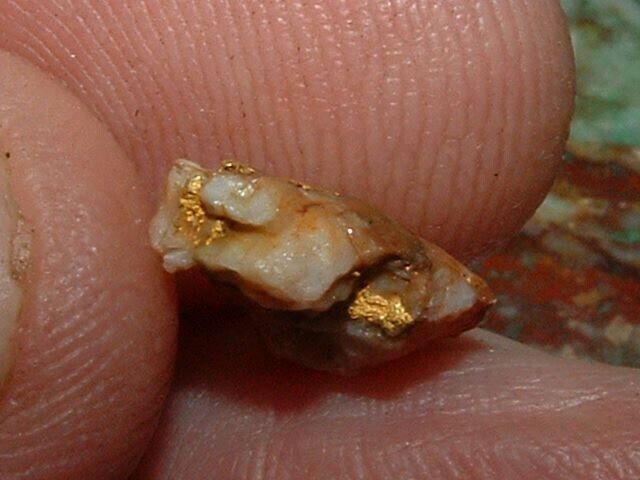-40%
RUSTY GOLD QUARTZ SPECIMEN .7 GRAM NATURAL GOLD IN QUARTZ
$ 20.59
- Description
- Size Guide
Description
ORANGEGOLD QUARTZ SPECIMEN
from
CALIFORNIA
R
uler is
1/4"
wide (6 mm). U.S. 10 cent coin is 17 mm in diameter.
S
pecimen weight:
.7
G
ram -
10.9
G
rains
S
ize:
10.2X9X4.8
mm
S
izable exposures of gold sparkle from both sides of this orange-stained quartz pebble. My source says it's from California's Mother Lode. Understandably, that encompasses a vast area. Since it's exact origin within this range is unknown, I'm unable to provide a specific mining district. For true aficionados of native gold, sometimes the host rock is every bit as interesting as the gold that's inside. Once a person becomes intimate with this precious metal we love so much, he longs for out-of-the-ordinary specimens; anomalous specimens which stand out. Y
our collection of micromounts should welcome this splendid addition. It's quite a conductive little piece appearing to harbor more gold inside.
For those who've kept track of my store these past several years, you know I don't sell low-grade specimens. If it shows gold, it can't be low grade ore.
I deal in naturally-occurring gold ores with visible gold. These high-grade beauties are hard to find and expensive to obtain. My prices aren't based upon the amount of gold contained, but on the fact that it's there.
U.S. SHIPPING - .00
(includes USPS tracking to all U.S. destinations)
INTERNATIONAL CUSTOMERS S&H
.00
FAST REFUND OFFERED
(If, for any reason, you're not happy with this item)
I poured through old mining dumps for years looking at orange-yellow-rusty rock through a loupe, but I never found a piece with visible gold.
Hydrothermal solutions carrying gold and silica crystallized into veins of gold quartz. This specimen comes from one of the many gold-bearing vein systems of California, The Golden State.
Weight Conversions:
15.43 GRAINS = 1 GRAM
31.103 GRAMS = 1 TROY OUNCE
24 GRAINS = 1 PENNYWEIGHT (DWT)
20 DWT = 1 TROY OUNCE
480 GRAINS = 1 TROY OUNCE
S & H
Discounted for combined shipments.
U.S. BUYERS & INTNL.
PAYMENTS
For U.S. buyers: We accept paypal
For intnl. customers: We accept paypal.
Pay securely with
www.paypal
.
Payment must be made within 7 days from close of auction. We ship as soon as funds clear. If you have questions, please ask them before bidding.
REFUNDS
We leave no stones unturned insuring our customers get what they bargained for.
If you're not satisfied with this item, contact me. Then, if the problem can't be fixed, return product within 30 days in 'as purchased' condition for a full refund
MINERS, CLAIMS, AND THE CALIFORNIA GOLD RUSH
This specimen represents a much higher grade of gold quartz
than typically would have been mined during the
Gold Rush. Ore containing
visible gold was not
considered
‘run-of-the-mill’.
The
lion’s
share
of ore extracted from hard rock mines active during the period
was
much
lower
in
tenor than 'specimen gold' such as this. These low-grade ores would most likely have
assayed less
than an ounce
of gold per
ton. Gold locked up inside it would seldom have been visible to the naked eye. A ton of ore comprised of specimen gold like the piece I'm offering would have made it's finder a very popular miner at local taverns. Many districts
in the
Mother Lode produced
high
grade
similar to this specimen
as
placer, as float often found in pediment zones,
chunks of
gold-
bearing
quartz which broke off
from richer sections of the main
vein. Of a similar
nature was
gold
dug from
close-to-the-surface
vein outcroppings. These epithermal deposits were characterized by the presence of 'caprock' or oxidized iron with gold mixed in. Featured rock fits this description. It’s a
well-
known
secret that during the Gold Rush years, when
opportunities
presented themselves, hard rock miners
high-graded (stole)
richer specimens
from mines where they worked
.
Some
miners, once they found gold
in quartz,
whether
‘high-graded’
or mined legally, undoubtedly
milled it up.
In that
manner, they
extracted
gold from the rock
themselves leaving no clues behind of where the gold might have came from.
Afterwards
, once separated from the worthless gangue material
(useful as evidence, maybe), the gold c
ould
be assayed, melted, weighed,
and sold.
Other
miners, and one
can only
speculate
at the
particulars involved in
such
transactions, probably
brought in
high
grade
rocks they found
to
assayers who, in addition to testing
the purity of gold and overall richness of vein filling
discovered
inside ore bodies,
may also have
been in
the
business
of
processing
and
buying larger amounts of high
grade ore
(rock like
this). One could
surmise
that likely as not every
merchant
in these
flourishing Mother
Lode towns
would,
by this time,
have learned plenty
about
the ins and outs of gold
mining.
Chances
are, they knew the
miners,
what
diggings
were
being
worked by
whom,
and
how
well
different mines
were faring
.
It stands
to reason
the
majority
of
local
towns-folk
and
business-
owners were
acquainted
with
mine
and
claim
owners
thereabouts
. One
might
think that as
stake-holders,
any and all
interested
adults
in the
community
would be well-
informed about
claims and mine status, mine ownership, mining technologies,
about
buying
and selling
gold,
processing
ores,
refining gold,
assaying gold, et al. If this were true, then it stands to reason that any high-graders actively engaged in theft at the mines would, by necessity, have resorted to every manner of deceptive practice to avoid detection and the scrutiny of townsfolk.
Thanks for checking out our digs.
G
old of
E
ldorado
1-14-13
















